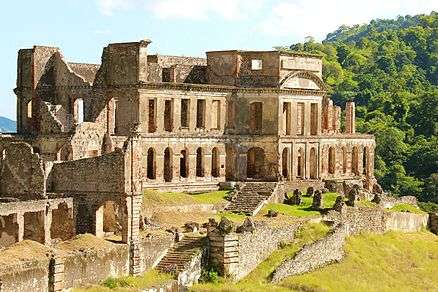Sans-Souci Palace
| Sans-Souci Palace | |
|---|---|
|
Aerial view of the front elevation | |
| Location | Milot, Nord Department, Haiti |
| Coordinates | 19°36′17″N 72°13′07″W / 19.604692°N 72.218596°WCoordinates: 19°36′17″N 72°13′07″W / 19.604692°N 72.218596°W |
| Built | 1813 |
| Built for | Henry I, King of Haïti |
| Official name: National History Park - Citadel, Sans Souci, Ramiers | |
| Type | Cultural |
| Criteria | iv, vi |
| Designated | 1982 (6th session) |
| Reference no. | 180 |
| State Party | Haiti |
| Region | Latin America and the Caribbean |
 Location of Sans-Souci Palace in Haiti | |

The Sans-Souci Palace is a palace in Haiti in the town of Milot, Nord Department.
It was the royal residence of King Henri I (better known as Henri Christophe) of Haiti, Queen Marie-Louise and their two daughters. It was the most important of nine palaces built by the king, as well as fifteen châteaux, numerous forts, and sprawling summer homes on his twenty plantations.[1] Construction of the palace started in 1810 and was completed in 1813. Its name translated from French means "carefree". The nearest airport and large city is Cap-Haitien.
Before the construction of Sans-Souci, Milot was a French plantation that Christophe managed for a period during the Haitian Revolution.[2] Many of Henri Christophe's contemporaries noted his ruthlessness, and it is unknown how many laborers died during the palace's construction. Under his reign, the palace was the site of opulent feasts and dances. It had immense gardens, artificial springs, and a system of waterworks. Though Sans-Souci is now an empty ruin, at the time its splendor was noted by many foreign visitors. One American physician remarked that it had "the reputation of having been one of the most magnificent edifices of the West Indies."[3]
The impressiveness of Sans-Souci was part of Henri Christophe's program to demonstrate to foreigners, particularly Europeans and Americans, the power and capability of the black race. The African pride in the construction of the king's palace was captured by the comment of his advisor, Pompée Valentin Vastey (Baron Valentin de Vastey), who said that the palace and its nearby church, "erected by descendants of Africans, show that we have not lost the architectural taste and genius of our ancestors who covered Ethiopia, Egypt, Carthage, and old Spain with their superb monuments."[4] However, Christophe's reign drew heavily on European monarchical signs of prestige. He established a hereditary nobility, along with coats of arms and prescribed ceremonial dress.
Close to the Palace is the renowned mountaintop fortress; the Citadelle Laferrière, built under decree by Henri Christophe to repel a feared French invasion that never occurred. It is reached by continuing on the trail behind the Palace. France, the former colonial power in Haiti, recognized Haiti's independence in 1825 when Haiti agreed to pay a ruinous indemnity of 150 million francs in return for diplomatic and economic relations.
Crippled by a stroke, King Henri I committed suicide on the grounds of the palace on October 8, 1820. According to Haitian legend, he shot himself with a silver bullet. He was subsequently buried in the Citadelle.
His son and heir, Jacques-Victor Henry, Prince Royal of Haiti was bayoneted to death by revolutionaries at the Palace on October 18, 1820.
Incidentally, the palace shares its name with another Haitian revolutionary leader, Colonel Jean-Baptiste Sans Souci. He was an African slave who may have taken his name from the quartier near the parish of Grande Rivière where he first led troops in guerrilla fighting against the French in 1791. When Henri Christophe and other military leaders split from the French, they asked Sans Souci to join their ranks, but he declined, and particularly viewed Christophe as a traitor. About ten years before the construction of his palace, the future Haitian king sent Colonel Sans Souci a conciliatory message inviting him to his headquarters at Grand Pré. When Sans Souci arrived at the plantation, Christophe's guards bayoneted him and his small band of guards to death.[5]
Some scholars have also asked whether Christophe took part of his inspiration for the palace from the Prussian king Frederick the Great's palace in Potsdam, Sanssouci, a symbol of European Enlightenment achievement.
A severe earthquake in 1842 destroyed a considerable part of the palace and devastated the nearby city of Cap-Haïtien; the palace was never rebuilt. The palace (before its destruction) was acknowledged by many to be the Caribbean equivalent of the Palace of Versailles in France.
UNESCO designated it—and the Citadelle—World Heritage Sites in 1982.
Described as "one of the most remarkable attractions in the Western Hemisphere", the Palace of Sans-Souci is "seldom visited by foreigners" due to "decades of political instability and lawlessness" in Haiti.[6] However, the area is relatively peaceful and easily accessible from the city of Cap-Haïtien.
References
- ↑ Cheesman, Clive (2007). The Armorial of Haiti: Symbols of Nobility in the Reign of Henri Christophe. London: The College of Arms.
- ↑ Trouillot, Michel-Rolph (1995). Silencing the Past. Boston: Beacon Press.
- ↑ Brown, Jonathan (1837). The History and Present Condition of St. Domingo. Philadelphia: W. Marshall.
- ↑ Pompée Valentin Baron de Vastey (1819). An Essay on the Causes of the Revolution and Civil Wars of Hayti. printed at the Western Luminary Office.
- ↑ Cole, Hubert (1967). Christophe: King of Haiti. London: Eyre & Spottiswoode.
- ↑ "Haiti's Sans-Souci Palace : A journey to the past", BBC, 17 April 2012
External links
 Media related to Sans-Souci Palace at Wikimedia Commons
Media related to Sans-Souci Palace at Wikimedia Commons- UNESCO World Heritage listing for the National History Park – Citadel, Sans Souci, Ramiers
- Explore Sans-Souci Palace with Google Earth on Global Heritage Network